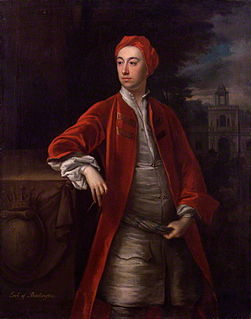
Richard Boyle, 3rd Earl of Burlington and 4th Earl of Cork, was an Anglo-Irish architect and noble often called the "Apollo of the Arts" and the "Architect Earl". The son of the 2nd Earl of Burlington and 3rd Earl of Cork, Burlington never took more than a passing interest in politics despite his position as a Privy Counsellor and a member of both the British House of Lords and the Irish House of Lords. His great interests in life were architecture and landscaping, and he is remembered for being a builder and a patron of architects, craftsmen and landscapers, Indeed, he is credited with bringing Palladian architecture to Britain and Ireland. His major projects include Burlington House, Westminster School, Chiswick House and Northwick Park.
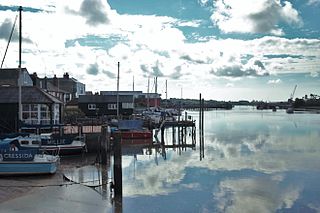
Wivenhoe is a town and civil parish in north-eastern Essex, England, approximately 3 miles (5 km) south-east of Colchester. Historically Wivenhoe village, on the banks of the River Colne, and Wivenhoe Cross, on the higher ground to the north, were two separate settlements; however, with considerable development in the 19th century, the two have since merged.
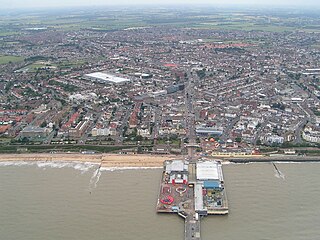
Clacton-on-Sea is a seaside town in the Tendring District in the county of Essex, England. It is located on the Tendring Peninsula and is the largest settlement in the Tendring District with a population of 56,874. The town is situated around northeast of London, from Chelmsford, from Southend-on-Sea, southeast of Colchester and south of Harwich. The town is a seaside resort on the southeast coast of England.

Wivenhoe Park is a landscaped green space of more than 200 acres (81 ha) at the eastern edge of Colchester, England. It is the site of Wivenhoe House, a four-star hotel, based in an eighteenth-century Grade II listed house. Wivenhoe House is also home to the Edge Hotel School, the first school of its kind in the UK and since October 2018 a department of the University of Essex.
Sir Frederick Ernest Gibberd was an English architect, town planner and landscape designer. He is particularly known for his work in Harlow, Essex, and for the BISF house, a design for a prefabricated council house that was widely adopted in post-war Britain.

Alresford is a village and electoral ward in Essex, England. It is centred 9 km (5.6 mi) southeast of Colchester and is 39 km (24 mi) northeast from the county town of Chelmsford. The village and its civil parish are the district of Tendring. The local primary school is Alresford Primary School and the village has a pre-school and church. Alresford won the Essex Village of the year competition in 2012 and tied for first place for another Essex Village of the Year award in 2019.

Cassiobury Park is the principal public park in Watford, Hertfordshire, in England. It was created in 1909 from the purchase by Watford Borough Council of part of the estate of the Earls of Essex around Cassiobury House which was subsequently demolished in 1927. It comprises over 190 acres (77 ha) and extends from the A412 Rickmansworth Road in the east to the Grand Union Canal in the west, and lies to the south of the Watford suburb of Cassiobury, which was also created from the estate. The western part is a 62-acre (25.1 ha) Local Nature Reserve managed by the Herts and Middlesex Wildlife Trust. The park hosts the free, weekly timed parkrun 5 km event every Saturday morning at 9 am, starting near the Shepherds Road entrance to the park.

Hylands House is a Grade II* neo-classical villa situated within Hylands Park a 232-hectare park south-west of Chelmsford in Essex in South East England. It is owned and operated by Chelmsford City Council.
The High Steward of Colchester is a ceremonial office awarded by Colchester Borough Council, Essex, England.
Edward Prioleau Warren was a British architect and archaeologist.

Craigiehall is a late-17th-century country house, which until 2015 served as the Headquarters of the British Army in Scotland. It is located close to Cramond, around 9 km (5.6 mi) west of central Edinburgh, Scotland.
Alexander Marshall MacKenzie was a Scottish architect responsible for prestigious projects including the headquarters of the Isle of Man Banking Company in Douglas, and Australia House and the Waldorf Hotel in London.

The Grove is a large hotel in Hertfordshire, England, with a 300–acre (1.2 km2) private park next to the River Gade and the Grand Union Canal. It touches on its north-west corner the M25 motorway and remains a small part in Watford. The estate is situated within three different settlements; most of the land and all of the mansion itself are in the civil parish of Sarratt, and also in the ecclesiastical parish of Langleybury, while the estate lies within the post town of Rickmansworth.
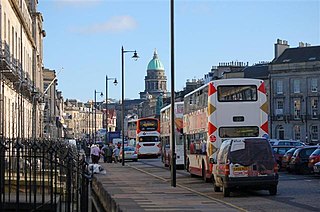
The West End is an affluent district of Edinburgh, Scotland, which along with the New and Old Towns forms central Edinburgh, and Edinburgh's UNESCO World Heritage Site. The area boasts several of the city's hotels, restaurants, independent shops, offices and arts venues, including the Edinburgh Filmhouse, Edinburgh International Conference Centre and the Caledonian Hotel. The area also hosts art festivals and crafts fairs.

John Gurdon Rebow was an English Liberal Party politician who sat in the House of Commons in two periods between 1857 and 1870.
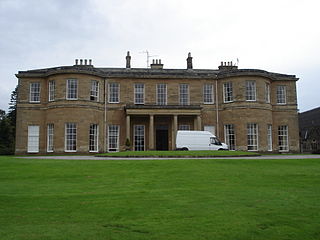
Rudding Park Hotel, Spa and Golf is a Grade I listed Regency-style country house in Harrogate, North Yorkshire, England.

Wivenhoe Park is a painting of an English landscape park, the estate of the Rebow family, by the English Romantic painter, John Constable (1776–1837).

Isaac Martin Rebow was a British landowner and politician who sat in the House of Commons between 1755 and 1781.
Bryan Keith Thomas is an architect in Essex, England, known for domestic architecture in that county such as the house at Beth Chatto Gardens in Elmstead Market. His church architecture has included Church of England, Christian Scientist and Quaker places of worship.
Sir Isaac Rebow was a clothier and merchant who served as Member of Parliament for Colchester in the late seventeenth and early eighteenth centuries.














